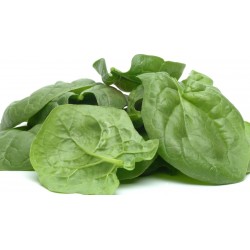Menu
-
MenuWstecz
- Home
-
Kategorie
-
-
Kategorie
-
Nasiona warzyw
-
Odmiany według kraju
- Odmiany z Armenii
- Odmiany z BiH
- Odmiany z Chorwacji
- Odmiany z Francji
- Varieties from Germany
- Varieties from Greece
- Varieties from Hungary
- Odmiany z Indii
- Varieties from Italy
- Odmiany z Japonii
- Odmiany z North Macedonii
- Varieties from Peru
- Varieties from Russia
- Varieties from Serbia
- Odmiany ze Słowenii
- Varieties from Spain
- Varieties from Thailand
- Odmiany z Turcji
- Varieties from USA
- Nasiona Pomidorów
- Nasiona kukurydzy
- Gurda rodziny
- Rodzina fasoli
- Nasiona Ogórka
- Nasiona Papryki
- Rodzina marchwi
- Rodzina cebuli
- Nasiona Sałaty
- Rodzina ziemniaków
- Rodzina kapuściana
- Nasiona Rzodkiewki
- Rodzina buraków
- Nasiona arbuza
- Nasiona melona
- Nasiona kalafiora
- Rodzina słoneczników
-
Odmiany według kraju
- Nasiona Owoców
- Nasiona Papryki Chili
- Nasiona ziół leczniczych
- Nasiona roślin pnących
- Drzewa - Krzewy - Nasiona
- Nasiona palmy
- Nasiona Traw Ozdobnych
- Nasiona tytoniu
-
Nasiona warzyw
-
-
-
-
- NOWE PRODUKTY
- Dostawa - płatność
- Utwórz konto
- FAQ
- Strona główna
-
- Nasiona warzyw
- Odmiany według kraju
- Odmiany z North Macedonii
- Odmiany z Chorwacji
- Odmiany z Turcji
- Odmiany z BiH
- Odmiany z Japonii
- Odmiany z Indii
- Odmiany z Armenii
- Odmiany z Francji
- Odmiany ze Słowenii
- Varieties from Serbia
- Varieties from Greece
- Varieties from Russia
- Varieties from Italy
- Varieties from Spain
- Varieties from USA
- Varieties from Germany
- Varieties from Peru
- Varieties from Thailand
- Varieties from Hungary
- Nasiona kalafiora
- Nasiona melona
- Nasiona arbuza
- Rodzina słoneczników
- Rodzina buraków
- Nasiona Rzodkiewki
- Nasiona Pomidorów
- Nasiona kukurydzy
- Gurda rodziny
- Rodzina fasoli
- Nasiona Ogórka
- Nasiona Papryki
- Rodzina kapuściana
- Rodzina ziemniaków
- Rodzina cebuli
- Nasiona Sałaty
- Rodzina marchwi
- Odmiany według kraju
- Opakowanie i takie tam
- Grzybnia Grzybowa
- Bulwy roślinne
- Przyprawy organiczne
- Rośliny Ajurwedy
- Nasiona hybrydowe F1
- Nasiona bananów
- Brak płatności PayPal i kartą X
- Olbrzymie Rośliny Nasiona
- Rośliny odporne na zimno
- Nasiona bambusa
- Pleśnie owocowe i warzywne
- Duże paczki nasion
- Nasiona Owoców
- Nasiona Papryki Chili
- Nasiona ziół leczniczych
- Nasiona roślin pnących
- Drzewa - Krzewy - Nasiona
- Nasiona palmy
- Nasiona Traw Ozdobnych
- Nasiona tytoniu
- Dostawa - płatność
- Instrukcje siewu
- Pielęgnacja roślin
- Apa plantează semințe
- Nasiona Kaktusa
- Nasiona kwiatów
- Nasiona warzyw
Last Product Reviews
These peppers came all the way from eastern Europe and took a while at no f...
By
 Fitim Berani on 21/09/2023
Fitim Berani on 21/09/2023
Verified Purchase
Last customers
- Tanja, Beograd, Serbia
- Alaa, Alwajh, Saudi Arabia
- ionescu, valu lui traian, Romania
- Lasse, 2900, Norway
- Pete, Cleves, United States
- Stef, Waalwijk, Netherlands
- Sonia, Minervino di Lecce, Italy
- Adrian, Ingolstadt, Germany
- CORINNE, NOTRE DAME DE LONDRES, France
- Dušan, KRAVANY NAD DUNAJOM, Slovakia
- Arno, Ehrenkirchen, Germany
- Costas, LARNACA , Cyprus
- Fulvio francesco, Santa Domenica Talao, Italy
- william, Dun, France
- Aymeric , Saint tricat, France
- Ricard, Sant Celoni, Spain
- Maureen , Enniscorthy Co Wexford , Ireland
- Paul, St. Vigil in Enneberg (BZ), Italy
- Ricardo jorge , Viseu , Portugal
- Radosav, Kragujevac, Serbia
- Sylvie, Neyruz, Switzerland
- Julien, Scionzier, France
- Zoran, Vinca, Serbia
- Josef, Hochdorf-Assenheim, Germany
- Davide, London, United Kingdom
- Kimberly, Victoria, Gozo, Malta
- Saša , Beograd, Serbia
- Ewa, Galway, Ireland
- Ioannis , Kato Achaia, Greece
- Samuele, Milano, Italy
Najczęściej kupowane
Jest 882 produktów.
Pokazano 409-420 z 882 pozycji
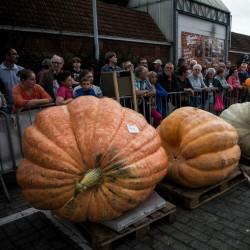
BIG MAX Pumpkin Heirloom Seeds
Cena
4,95 €
SKU: VG 51
Seeds Gallery Com,
5/
5
<!DOCTYPE html>
<html>
<head>
<meta http-equiv="Content-Type" content="text/html; charset=UTF-8" />
</head>
<body>
<h2><strong>BIG MAX Pumpkin Heirloom Seeds</strong></h2>
<h2><span style="color: #ff0000;"><strong>Price for Package of 4 seeds.</strong></span></h2>
<p>(C. maxima) 110 days Huge pumpkins can grow well over 50 kg - 100 lbs! Nearly round, bright orange fruit are stunning and are good for pies and canning. Very thick, orange flesh. Good for county fairs and displays.</p>
<p><strong>GARDIN HINTS:</strong> Let one or two pumpkins only develop per vine for largest size.</p>
</body>
</html>
VG 51 (4 S)


Peru'dan Çeşitli

Bu bitki yenilebilir
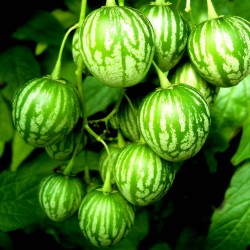
Wild Pepino - Tzimbalo...
Cena
4,00 €
SKU: V 213
Seeds Gallery Com,
5/
5
<meta http-equiv="Content-Type" content="text/html; charset=UTF-8" />
<h2><strong>Wild Pepino - Tzimbalo Seeds (Solanum caripense)</strong></h2>
<h2><span style="color: #ff0000;"><strong>Price for Package of 5 seeds.</strong></span></h2>
<p>Solanum caripense is a species of evergreen shrub native to South America and grown for its edible fruit.</p>
<p>Rare in cultivation, it is known as Tzimbalo. Tzimbalo is a herbaceous shrub with deep green, lanceolate leaves that reaches a height of 30-50 cm. The fruit closely resembles the related Pepino, and it has been speculated that Solanum caripense may be the wild ancestor of the Pepino. Like the Pepino, the Tzimbalo is a relative of other nightshades cultivated for their edible fruit, including the tomato (S. lycopersicum), the naranjilla (S. quitoense) and the eggplant (S. melongena).</p>
<p>The fruit is infrequently cultivated in its native range of Colombia, Ecuador, Bolivia, Peru, and Chile, but has been rediscovered on a small scale by heirloom gardeners elsewhere in the world. The Tzimbalo is presumed to be native to the temperate Andean regions of Colombia, Peru, and Chile. Like the Pepino, the Tzimbalo can bear fruit within 1 or 2 years from seed.</p>
<p>The fruits are round berries, to 2 cm in size, which ripens to yellow or pale green, with dark-colored longitudinal stripes. The flavor and texture, while similar to the Pepino, tends to be tangier and juicier. Like the Pepino, the Tzimbalo performs best in a warm, relatively frost-free climates. The plant can survive a low temperature of -2.5 °C (27 to 28 °F) if the freeze is very short, though it may drop many of its leaves. Like its close relatives, the species is a perennial, but its sensitivity to chilling, pests and diseases, along with its relatively long growing season serve as hindrances to large scale commercial exploitation.</p>
<p>The Tzimbalodoes adapt well to greenhouse cultivation. Like most edible nightshades, the Tzimbalo is highly attractive to pests like aphids, whiteflies, beetles, and spider mites.</p>
V 213 (10 S)

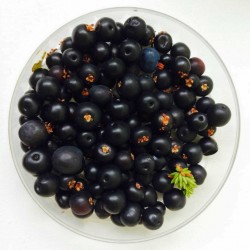
Crowberry, Black Crowberry...
Cena
1,95 €
SKU: V 212
Seeds Gallery Com,
5/
5
<h2><strong>Crowberry, Black Crowberry Seeds (Empetrum nigrum)</strong></h2>
<h2><span style="color:#ff0000;"><strong>Price for Package of 5 seeds.</strong></span></h2>
<p>Empetrum nigrum, crowberry, black crowberry, or, in western Alaska, blackberry, is a flowering plant species in the heather family Ericaceae with a near circumboreal distribution in the northern hemisphere. It is also native in the Falkland Islands. It is usually dioecious, but there is a bisexual tetraploid subspecies, Empetrum nigrum ssp. hermaphroditum, that occurs in more northerly locations and at higher altitude.</p>
<p>Evolutionary biologists have explained the striking geographic distribution of crowberries as a result of long-distance migratory birds dispersing seeds from one pole to the other.</p>
<p>The metabolism and photosynthetic parameters of Empetrum can be altered in winter-warming experiments.</p>
<p>The leaves are 3–6 mm (0.12–0.24 in) long, arranged alternately along the stem. The fruits are drupes, 4–6 mm (0.16–0.24 in) wide, usually black or purplish-black but occasionally red.</p>
<p>The fruits contain mostly water. Their vitamin content is low, as is the concentration of volatile liquids, the lack of which makes them almost odorless. The acidity is lower than is typically encountered in forest berries, and benzene acids are almost absent.</p>
<h3><strong>Cultivation and uses</strong></h3>
<p>E. nigrum can be grown in acidic soils in shady, moist areas. It can be grown for the edible fruit, as a ground cover,[11] or as an ornamental plant in rock gardens, notably the yellow-foliaged cultivar 'Lucia'. The fruit is high in anthocyanin pigment and can be used to make a natural food dye.</p>
<p>After waning popularity, E. nigrum is regaining its reputation as an edible fruit. It provides a steady crop and the gathering is relatively easy. Cooking enhances the flavor. The fruits make good pie and jam.</p>
<p>In subarctic areas, E. nigrum has been a vital addition to the diet of the Inuit and the Sami. The Dena'ina (Tanaina) harvest it for food, sometimes storing in quantity for winter, and like it mixed with lard or oil. The fruits are usually collected in fall, but if not picked they may persist on the plant and can be picked in the spring. They keep well in a cool place without any special preparation. The Inuit and Native Americans mix them with other berries, especially blueberries.</p>
<p>The leaves and stems are used in Dena'ina medicine for diarrhea and stomach problems; they are boiled or soaked in hot water, and the strained liquid drunk. In Dena'ina plant lore in the Outer and Upper Inlet area of Lake Clark, the root is also used as a medicine, being used to remove a growth on an eye and to heal sore eyes. The roots are boiled and the eyes are washed with the strained, cooled tea, to which a little sugar may be added.</p>
<p>In Labrador, where the name "blackberry" is used, the smoke of the burning stems and leaves is used to smoke fish, notably Salmon, Sea Trout, and Arctic Char.</p>
<p><strong>Nutrition Benefits of Black Crowberries</strong></p>
<p>Low in fat, saturated fat-free, cholesterol-free, sodium-free, and an excellent source of manganese, copper, and vitamin C Although the crowberry provides the third-largest harvest of all berries (after blueberries and lingonberries) it is almost unknown outside the arctic regions. In the Nordic countries, the use of wild berries has long traditions in home cooking as well as for therapeutic purposes.</p>
<p>Crowberry is an evergreen shrub native to cool regions of North America, Asia, and Europe. In the southern hemisphere, it is found on Falkland islands. The fruits are black round berries.</p>
<p>It is interesting to note that crowberry is fighting other species by producing a toxin. Crowberry leaves have small glands that produce batatasin III. The leaves live two to four years, and when they die and end up on the ground where they break down slowly and continues to leak its water-soluble toxin. The toxin blocks other species to grow what makes free living space to the crowberries.</p>
<p>Crowberry is not edible raw unless as a replacement for water. Crowberry has a taste that is slightly acidic and bitter. The berry contains tannins what makes its taste unpleasant.</p>
<p>It is typically used cooked, seldom fresh. The berries have been used as raw material for juice, jelly, wine and sweets. Crowberries are eaten in akutaq, Eskimo's ice cream.</p>
<p>Crowberries are widely used in folk medicine for treating epilepsy, paralysis, nervous disorders and anthrax. In Russia, a medicine for treating epilepsy (Empetrin) is produced.</p>
<p>Crowberries have an astringent and diuretic effect.</p>
<p>Crowberry is a rich (460 mg / 100 g berries) source of anthocyans. (2) The increased interest in flavonoids and other phenolics as health-benefiting compounds can lead to an increased usage of the crowberries.</p>
<p>Crowberries are a source of botanicals for the preparation of cosmetic products.</p>
<p>Crowberry is not an economically important crop. The crowberry anthocyanins are a potential source of natural colorants but largely unused. Due to the toughness of the crowberry plant, it has been used as pan scrubbers and brooms.</p>
<p>The ability of natural dyes to color textiles has been known since ancient times. Crowberries are used as natural dyes for centuries. Old recipes from Swedish Lapland proposed several different crowberry treatments and cooking times to produce different shades of green, yellow and brown. Both the berries and the plant were used for dying the textile.</p>
<p>Blueberries: They are dark-blue or purple in color. They are used in jams, purée, juice, pies, and muffins. They contain high levels of antioxidants and can help prevent many diseases, like stomach ailments, heart degeneration, and heart diseases.</p>
<p>Huckleberries: These are small round berries that look and taste similar to blueberries. They come in colors ranging from deep crimson to eggplant purple. They are used to make excellent jams, pies, syrups, and preservatives.</p>
<p>Bilberries: Bilberries are edible berries that are closely related to blueberries and huckleberries. They are nearly black in color with a slight hue of purple. The pulp is red or purple in color and can stain your fingers while eating the raw fruit. They are very difficult to cultivate and fruits are generally collected from the wild. They are used in different jams and dishes or eaten raw.</p>
<h2>EDIBLE AND MEDICINAL PLANT</h2>
V 212


Bu bitki kış ve dona dayanıklıdır. Açıklamanın daha fazlaörneğine bakın.
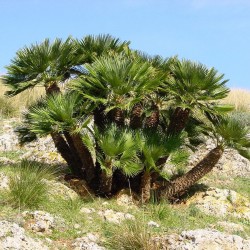
Mediterranean dwarf palm...
Cena
3,00 €
SKU: PS 9
Seeds Gallery Com,
5/
5
<h2><span style="font-size:14pt;"><strong>European fan palm, Mediterranean dwarf palm Seeds (Chamaerops humilis)</strong></span></h2>
<h2><span style="color:#ff0000;font-size:14pt;"><strong>Price for Package of 3 seeds.</strong></span></h2>
<p>Chamaerops is a genus of flowering plants in the palm family Arecaceae. The only currently fully accepted species is Chamaerops humilis, variously called European fan palm, or the Mediterranean dwarf palm. It is one of the more cold-hardy palms used in landscaping in temperate climates.</p>
<p>Chamaerops humilis is a shrub-like clumping palm, with several stems growing from a single base. It has an underground rhizome which produces shoots with palmate, sclerophyllous leaves.</p>
<p>The stems grow slowly and often tightly together, eventually reaching 2–5 m (10–20 ft) tall with a trunk diameter of 20–25 cm (8–10 in). It is a fan palm (Arecaceae tribe Corypheae), and as such, has leaves with petioles terminating in rounded fans of 10–20 leaflets. Each leaf is up to 1.5 m (5 ft) long, with leaflets 50–80 cm (20–30 in) long. The petioles are armed with numerous sharp, needle-like spines; these may protect the stem growing point from browsing animals.</p>
<p>The flowers are borne in dense, short inflorescences at the tops of the stems. The plants usually, but not invariably, are dioecious with male and female flowers on separate plants. The prophyll covers the flowers on the inflorescence until the sexual phase (anthesis) and then splits open apically into two triangular lobes. The number of flowers per inflorescence is highly variable for both male and female plants, depending on the size of the inflorescence. Female flowers are tri-ovulate.[6] Unripe fruits are bright green, turning to dull yellow to brown as they ripen during autumn (September–November). The seed (usually 0.6–0.8 g or 1⁄50–3⁄100 oz) contains a small cylindrical embryo, which is surrounded by several layers, from inner to outer as follows:</p>
<p>a nutritious endosperm,</p>
<p>a wide woody layer or endocarp,</p>
<p>a fleshy and fibrous mesocarp (the pulp), and</p>
<p>the thin outer layer or exocarp.</p>
<p><strong>Taxonomy</strong></p>
<p>Apart from the fully accepted Chamaerops humilis there currently are a few species of unresolved status plus tens of species synonymised with Chamaerops humilis.</p>
<p>The species Chamaerops humilis itself has three accepted varieties as follows:</p>
<p>Chamaerops humilis var. argentea André (syn. C. h. var. cerifera) – "Atlas mountain palm" of Northwest Africa. Leaves glaucous.</p>
<p>Chamaerops humilis var. epondraes – Northwest Africa. Leaves glaucous.</p>
<p>Chamaerops humilis var. humilis – Southwest Europe. Leaves green.</p>
<p>There also are at least three cultivars (C. humilis var. humilis 'Nana', C. humilis 'Vulcano', C. humilis 'Stella'). C. humilis 'Vulcano' is a compact, thornless cultivar. May be silvery, but less so than argentea. The leaves tend to be thicker, and the appearance of the plant is bushier than var. humilis or var. argentea.</p>
<p>The genus Chamaerops is closely related to the genus Trachycarpus. The genera differ in that Trachycarpus lacks the clumping habit only forms single stems without basal suckers), the spiny leaf stems (spineless in Trachycarpus), and in small details of the flower anatomy.</p>
<p><strong>Distribution</strong></p>
<p>Chamaerops humilis is one of only two palm species native to southern Europe, the other being Phoenix theophrasti. It is mainly found in southwestern Europe (Malta, Sicily, over all the Mediterranean coast of Spain and Portugal, central and southern Italy, some parts of the southern Mediterranean coast of France and Monaco, as well as northwest Africa (Morocco, Algeria, Tunisia). It is the northernmost naturally occurring palm in the world, with the northernmost standing at Hyères-les-Palmiers, at 43° 07′ N.</p>
<p><strong>Cultivation</strong></p>
<p>Chamaerops humilis is valued in gardening and landscaping in many parts of the world. It is very drought-tolerant once established.</p>
<p><strong>It is hardy to −12 °C (10 °F), but does prefer hot summers. </strong></p>
<p>It is a very slow-growing plant. The blue form of the species, native to high elevations of the Atlas Mountains, has recently been introduced into the trade and early reports indicate that it may be −12 °C (−22 °F) or more degrees hardier than the green form.</p>
<p>It has gained the Royal Horticultural Society's Award of Garden Merit.</p>
<p><strong>Ecology and interactions with animals</strong></p>
<p>Chamaerops humilis flowers in spring, typically from April to May. The plant also may be partly anemophilous, that is to say, wind-pollinated, but it is at least partly entomophilous, that is to say dependent on pollination by insects. Only one insect species is known to pollinate it, namely a specific weevil, Derelomus chamaeropsis in the family Curculionidae.[13] The nature of the relationship with the weevil is a version of nursery pollination mutualism with the weevil; the form this takes is that once pollinating weevils have found a satisfactory plant, whether male or female, they usually stay on the same plant until the end of its anthesis, finding shelter, egg-laying sites, and food in the inflorescences.</p>
<p>At anthesis, as is common in Angiosperms, both male and female Chamaerops humilis plants attract their pollinators with chemical compounds, but an unusual feature is that their scents are released by the leaves, and not by the flowers.[15] Towards the end of anthesis, weevils leave the plant and seek a new host plant, again either male or female.</p>
<p>Larval development of the weevil Derelomus chamaeropsis occurs within rachises of inflorescences of male plants during autumn and winter. At the beginning of the next flowering period, adult weevils emerge from the dry and brittle stems of old inflorescences of the previous year of male plants only. Those that hatch in female plants die without concluding their development. This is because the palmettos are adapted to prevent the pollinating weevils from destroying the female inflorescences with their burden of seed. Weevils have been shown to lay eggs within female inflorescences, but as soon as seeds start to develop, eggs or larvae fail to continue their life cycle. On the other hand, male inflorescences have completed their function after pollination, so it is advantageous to the plant's reproduction for the weevils to complete their life cycles and shelter in the male inflorescences, thereby remaining available for pollination when they emerge in the following season.</p>
<p>The ripe pulp of C. humilis has several important functions.</p>
<p>When ripened, the pulp smells strongly of rancid butter[18] and thus acts as a foraging cue for nocturnal frugivores that commonly are fundamentally carnivorous mammals such as badgers and foxes.</p>
<p>The pulp inhibits germination, ensuring that the seed does not germinate until has been dispersed.</p>
<p>The pulp also acts as a chemical or physical barrier against invertebrate seed predators, typically beetles, and in particular weevils.</p>
<p>Because of the combination of such functions in the pulp, the palm both benefits and suffers adverse consequences when carnivores feed on the fruit and thereby remove the pulp. On the one hand, the seeds that carnivores swallow, germinate more frequently than seeds in entire fruit. On the other hand, ingested seeds are more frequently destroyed by invertebrate pests than non-ingested seeds. However, because of the mobility of carnivores, their dispersal service is important to the palmetto, given the severe fragmentation and isolation of most populations across the increasingly densely populated Mediterranean basin.</p>
<p><strong>Uses and threats</strong></p>
<p>Chamaerops humilis has a wide distribution in uncultivated land, and it is adapted to regimes of frequent burning, which it survives largely by re-sprouting from underground rhizomes and from fire-damaged stems. Such factors make the species ecologically important in preventing erosion and desertification and in providing shelter and food to many species of animals.</p>
<p>Apart from its material benefits, this palmetto is of emotional value as a charismatic component of the "garrigues" and "macchias" of the Mediterranean coastline.</p>
<p>The leaves of the adult plants have been used to make brooms and for weaving mats, carrier baskets, and similar articles. For finer work the young, unopened leaves are treated with sulphur to soften them softer and provide supple fibre.</p>
<p>The husk, known in southern Spain as "higa", is edible before it becomes too tough to eat as it matures. Because of their bitterness and high tannin content, the fruit are not used for human food, but in traditional medicine they have been used as an astringent.[19]</p>
<p>Urbanization and other human activities are making such rapid inroads into the natural habitat of palmetto that they are raising concerns about its future and that of its environment. Accordingly there is an increase in regulations to protect both its stands and those of associated Mediterranean endemics.</p>
<p>Another conservation problem is that particularly in the northernmost parts of its natural range, Chamaerops humilis is seriously threatened by an introduced South American moth Paysandisia archon.[9][20] Also, this Mediterranean native palm is affected by the introduction of related ornamental species because of the concurrent introduction of seed predators (such as Coccotrypes dactyliperda and Dactylotrypes longicollis) that feed on both the introduced and native palms.</p>
PS 9 (3 S)

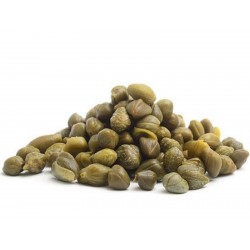
Caper bush, Flinders Rose...
Cena
1,95 €
SKU: VE 10
Seeds Gallery Com,
5/
5
<h2><strong>Caper bush, Flinders Rose Seeds (Capparis spinosa)</strong></h2>
<h2><span style="color:#ff0000;"><strong>Price for Package of 10 seeds.</strong></span></h2>
<p>Capparis spinosa, the caper bush, also called Flinders rose, is a perennial plant that bears rounded, fleshy leaves and large white to pinkish-white flowers.</p>
<p><strong>The plant is best known for the edible flower buds (capers), often used as a seasoning, and the fruit (caper berries), both of which are usually consumed pickled.</strong> Other species of Capparis are also picked along with C. spinosa for their buds or fruits. Other parts of Capparis plants are used in the manufacture of medicines and cosmetics.</p>
<p>Capparis spinosa is found in the wild in the Mediterranean, East Africa, Madagascar, South-Western and Central Asia, the Himalayas, the Pacific Islands, Indomalaya, and Australia.[6] It is present in almost all the circum-Mediterranean countries, and is included in the flora of most of them, but whether it is indigenous to this region is uncertain. Although the flora of the Mediterranean region has considerable endemism, the caper bush could have originated in the tropics, and later been naturalized to the Mediterranean basin.</p>
<p>The taxonomic status of the species is controversial and unsettled. Species within the genus Capparis are highly variable, and interspecific hybrids have been common throughout the evolutionary history of the genus. As a result, some authors have considered C. spinosa to be composed of multiple distinct species, others that the taxon is a single species with multiple varieties or subspecies, or that the taxon C. spinosa is a hybrid between C. orientalis and C. sicula.</p>
<p><strong>Plant</strong></p>
<p>The shrubby plant is many-branched, with alternate leaves, thick and shiny, round to ovate. The flowers are complete, sweetly fragrant, and showy, with four sepals and four white to pinkish-white petals, and many long violet-colored stamens, and a single stigma usually rising well above the stamens.</p>
<p><strong>Culinary uses</strong></p>
<p>The salted and pickled caper bud (called simply a caper) is often used as a seasoning or garnish. Capers are a common ingredient in Mediterranean cuisine, especially Cypriot, Italian, Aeolian and Maltese. The mature fruit of the caper shrub are prepared similarly and marketed as caper berries.</p>
<p>The buds, when ready to pick, are a dark olive green and about the size of a fresh kernel of corn (Zea mays). They are picked, then pickled in salt, or a salt and vinegar solution, and drained. Intense flavor is developed as mustard oil (glucocapparin) is released from each caper bud. This enzymatic reaction leads to the formation of rutin, often seen as crystallized white spots on the surfaces of individual caper buds.</p>
<p>Capers are a distinctive ingredient in Italian cuisine, especially in Sicilian, Aeolian and southern Italian cooking. They are commonly used in salads, pasta salads, meat dishes, and pasta sauces. Examples of uses in Italian cuisine are chicken piccata and spaghetti alla puttanesca.</p>
<p>Capers are known for being one of the ingredients of tartar sauce. They are often served with cold smoked salmon or cured salmon dishes (especially lox and cream cheese). Capers and caper berries are sometimes substituted for olives to garnish a martini.</p>
<p>Capers are categorized and sold by their size, defined as follows, with the smallest sizes being the most desirable: non-pareil (up to 7 mm), surfines (7–8 mm), capucines (8–9 mm), capotes (9–11 mm), fines (11–13 mm), and grusas (14+ mm). If the caper bud is not picked, it flowers and produces a caper berry. The fruit can be pickled and then served as a Greek mezze.</p>
<p>Caper leaves, which are hard to find outside of Greece or Cyprus, are used particularly in salads and fish dishes. They are pickled or boiled and preserved in jars with brine—like caper buds.</p>
<p>Dried caper leaves are also used as a substitute for rennet in the manufacturing of high-quality cheese.</p>
<p><strong>Nutrition</strong></p>
<p>Canned, pickled capers are 84% water, 5% carbohydrates, 2% protein, and 1% fat (table).</p>
<p>Preserved capers are often particularly high in sodium content. In a typical serving of 28 grams (one ounce), capers supply 6 calories and 35% of the Daily Value (DV) for sodium, with no other nutrients in significant content. In a 100 gram amount, the sodium content is 2960 mg or 197% DV, with vitamin K (23% DV), iron (13% DV), and riboflavin (12% DV) also having appreciable levels (table).</p>
<p><strong>Environmental requirements</strong></p>
<p>The caper bush requires a semiarid or arid climate.</p>
<p>The caper bush has developed a series of mechanisms that reduce the impact of high radiation levels, high daily temperature, and insufficient soil water during its growing period.</p>
<p>The caper bush has a curious reaction to sudden increases in humidity; it forms wart-like pock marks across the leaf surface. This is apparently harmless, as the plant quickly adjusts to the new conditions and produces unaffected leaves.</p>
<p>It also shows characteristics of a plant adapted to poor soils. This shrub has a high root/shoot ratio and the presence of mycorrhizae serves to maximize the uptake of minerals in poor soils. Different nitrogen-fixing bacterial strains have been isolated from the caper bush rhizosphere, playing a role in maintaining high reserves of that growth-limiting element.</p>
<p><strong>Cultivation</strong></p>
<p>The caper bush has been introduced as a specialized culture in some European countries in the last four decades. The economic importance of the caper plant led to a significant increase in both the area under cultivation and production levels during the late 1980s. The main production areas are in harsh environments found in Morocco, the southeastern Iberian Peninsula, Turkey, and the Italian islands of Pantelleria and Aeolian Islands, especially Salina. This species has developed special mechanisms to survive in the Mediterranean conditions, and introduction in semiarid lands may help to prevent the disruption of the equilibrium of those fragile ecosystems.</p>
<p>A harvest duration of at least three months is necessary for profitability.</p>
<p>Intense daylight and a long growing period are necessary to secure high yields. The caper bush can withstand temperatures over 40 °C in summer, but it is sensitive to frost during its vegetative period. A caper bush is able to survive low temperatures in the form of stump, as happens in the foothills of the Alps. Caper plants are found even 3,500 m above sea level in Ladakh, though they are usually grown at lower altitudes. Some Italian and Argentine plantings can withstand strong winds without problems, due to caper bush decumbent architecture and the coriaceous consistency of the leaves in some populations.</p>
<p>Scientists can use the known distributions of each species to identify the origin of commercially prepared capers.</p>
<p>The caper bush is a rupicolous species.[20] It is widespread on rocky areas and is grown on different soil associations, including alfisols, regosols, and lithosols. In different Himalayan locations, C. spinosa tolerates both silty clay and sandy, rocky, or gravelly surface soils, with less than 1% organic matter. It grows on bare rocks, crevices, cracks, and sand dunes in Pakistan, in dry calcareous escarpments of the Adriatic region, in dry coastal ecosystems of Egypt, Libya, and Tunisia, in transitional zones between the littoral salt marsh and the coastal deserts of the Asian Red Sea coast, in the rocky arid bottoms of the Jordan valley, in calcareous sandstone cliffs at Ramat Aviv, Israel, and in central west and northwest coastal dunes of Australia. It grows spontaneously in wall joints of antique Roman fortresses, on the Western Wall of Jerusalem's Temple Mount, and on the ramparts of the castle of Santa Bárbara (Alicante, Spain). Clinging caper plants are dominant on the medieval limestone-made ramparts of Alcudia and the bastions of Palma (Majorca, Spain). This aggressive pioneering has brought about serious problems for the protection of monuments.</p>
<p><strong>Propagation</strong></p>
<p>Capers can be grown easily from fresh seeds gathered from ripe fruit and planted into well-drained seed-raising mix. Seedlings appear in two to four weeks. Old, stored seeds enter a state of dormancy and require cold stratification to germinate. The viable embryos germinate within three to four days after partial removal of the lignified seed coats.[21] The seed coats and the mucilage surrounding the seeds may be ecological adaptations to avoid water loss and conserve seed viability during the dry season.</p>
<p>Use of stem cuttings avoids high variability in terms of production and quality. Nevertheless, plants grown from cuttings are more susceptible to drought during the first years after planting. The caper bush is a difficult-to-root woody species, and successful propagation requires careful consideration of biotypes and seasonal and environmental parameters. Rootings up to 55% are possible when using one-year-old wood, depending on cutting harvest time and substrate used. Propagation from stem cuttings is the standard method for growing ‘Mallorquina’ and ‘Italiana’ in Spain, and ‘Nocella’ in the Aolian Islands, esp. Salina. Hardwood cuttings vary in length from 15 to 50 cm and diameter of the cuttings may range from 1.0 to 2.5 cm. Another possibility is to collect stems during February through the beginning of March, treat them with captan or captafol and stratify them outdoors or in a chamber at 3–4 °C, covered with sand or plastic. Moisture content and drainage should be carefully monitored and maintained until planting. Using semihardwood cuttings, collected and planted during August and September, low survival rates (under 30%) have been achieved. Softwood cuttings are prepared in April from 25- to 30-day shoots. Each cutting should contain at least two nodes and be six to 10 cm long. Basal or subterminal cuttings are more successful than terminal ones. Then, cuttings are planted in a greenhouse under a mist system with bottom heat; 150 to 200 cuttings/m2 may be planted.</p>
<p><strong>Orchard establishment</strong></p>
<p>Mean annual temperatures in areas under cultivation are over 14 °C and rainfall varies from 200 mm/year in Spain to 460 mm/year in Pantelleria and 680 mm/year in Salina. In Pantelleria, it rains only 35 mm from May through August, and 84 mm in Salina, the Aeolian Islands. A rainy spring and a hot dry summer are considered advantageous.[22] This drought-tolerant perennial plant is used for landscaping and reducing erosion along highways, steep rocky slopes, sand dunes or fragile semiarid ecosystems.</p>
<p>Caper plantings over 25 to 30 years old are still productive.[23] Thus, physical properties of the soil (texture and depth) are particularly important. Caper bushes can develop extensive root systems and grow best on deep, nonstratified, medium-textured, loamy soils. Mouldboard plowing and harrowing are usual practices prior to caper plant establishment. Soil-profile modification practices, such as deep plowing operating 0.6 to 1 m, can ameliorate some restrictions. In Pantelleria, digging backhoe pits for each shrub was found to be the most effective means of cultivating caper in rocky soils. Two planting designs are used, the square/rectangle and the hedgerow system. Spacing is determined by the vigour of the biotype, fertility of the soil, equipment used and the irrigation method, if any. Bush spacing of 2.5 × 2.5 m or 2.5 × 2 m is common in Pantelleria. In Salina, the Aeolian Islands, 3 × 3 m is satisfactory for ‘Nocella’. In Spain, 4 × 4 m or 5 × 5 m is satisfactory for ‘Mallorquina’. Spacing of 2.0 to 2.5 m is appropriate if C. spinosa is used to control soil erosion on slopes.</p>
<p><strong>Polyphenols</strong></p>
<p>Canned capers contain polyphenols, including the flavonoids quercetin (173 mg per 100 g) and kaempferol (131 mg per 100 g), as well as anthocyanins.</p>
<p><strong>History</strong></p>
<p>The caper was used in ancient Greece as a carminative. It is represented in archaeological levels in the form of carbonised seeds and rarely as flower buds and fruits from archaic and Classical antiquity contexts. Athenaeus in Deipnosophistae pays a lot of attention to the caper, as do Pliny (NH XIX, XLVIII.163) and Theophrastus.</p>
<p>Etymologically, the caper and its relatives in several European tongues can be traced back to Classical Latin capparis, “caper”, in turn borrowed from the Greek κάππαρις, kápparis, whose origin (as that of the plant) is unknown but is probably Asian. Another theory links kápparis to the name of the island of Cyprus (Κύπρος, Kýpros), where capers grow abundantly.</p>
<p>In Biblical times, the caper berry was apparently supposed to have aphrodisiac properties;[29] the Hebrew word aviyyonah (אֲבִיּוֹנָה) for caperberry is closely linked to the Hebrew root אבה (avah), meaning "desire".[30] The word occurs once in the Bible, in the book of Ecclesiastes, at verse 12:5.</p>
<p>The King James Version translates on the basis of the Hebrew root (and perhaps the metaphorical meaning):[31]</p>
<p>...the grasshopper shall be a burden,</p>
<p>and desire shall fail. (12:5 KJV)</p>
<p>The medieval Jewish commentator Rashi also gives a similar gloss (12:5 JPR). However, ancient translations, including the Septuagint, Vulgate, Peshitta and Aquila, render the word more concretely as κάππαρις, "caper berry".[29] Thus in the words of one modern idiomatic translation (2004),</p>
<p>...the grasshopper loses its spring,</p>
<p>and the caper berry has no effect; (12:5 HCSB)</p>
<p>Of other modern versions, the NIV goes for "desire" (12:5 NIV), while the NASB has "caper-berry" (12:5 NASB), as did the 1917 Jewish Publication Society version (12:5 JPS).</p>
<p>The berries (abiyyonot) were eaten, as appears from their liability to tithes and to the restrictions of the 'Orlah. They are carefully distinguished in the Mishnah and the Talmud from the caper leaves, alin, shoots, temarot,[32] and the caper buds, capperisin (note the similarity "caper"isin to "caper");[33] all of which were eaten as seen from the blessing requirement, and declared to be the fruit of the ẓalef or caper plant.</p>
<p>Talmud Bavli, Gemara Berachot, page 36 A&B, discusses the eating of caper sepals versus caper berries, both inside the land of Israel, outside the land of Israel, and in Syria.</p>
VE 10 (10 S)

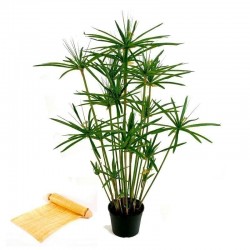
Papyrus Sedge, Paper Reed...
Cena
2,35 €
SKU: MHS 10
Seeds Gallery Com,
5/
5
<!DOCTYPE html>
<html>
<head>
<meta http-equiv="Content-Type" content="text/html; charset=UTF-8" />
</head>
<body>
<h2><strong><em><span style="text-decoration: underline;">Papyrus Sedge, Paper Reed Seeds (Cyperus papyrus)</span></em></strong></h2>
<h3><span style="color: #ff0000;"><strong>Price for Package of 10 seeds. </strong></span></h3>
<p>Cyperus papyrus (papyrus sedge, paper reed, Indian matting plant, Nile grass) is a species of aquatic flowering plant belonging to the sedge family Cyperaceae. It is a tender herbaceous perennial, native to Africa, and forms tall stands of reed-like swamp vegetation in shallow water.</p>
<p>Papyrus sedge (and its close relatives) has a very long history of use by humans, notably by the Ancient Egyptians—it is the source of papyrus paper, one of the first types of paper ever made. Parts of the plant can be eaten, and the highly buoyant stems can be made into boats. It is now often cultivated as an ornamental plant.</p>
<p>In nature, it grows in full sun, in flooded swamps, and on lake margins throughout Africa, Madagascar, and the Mediterranean countries.</p>
<p>C. papyrus and the dwarf cultivar C. papyrus 'Nanus'[3] have gained the Royal Horticultural Society's Award of Garden Merit.</p>
<p>This tall, robust, leafless aquatic plant can grow 4 to 5 m (13 to 16 ft) high. It forms a grass-like clump of triangular green stems that rise up from thick, woody rhizomes. Each stem is topped by a dense cluster of thin, bright green, thread-like stems around 10 to 30 cm (4 to 10 in) in length, resembling a feather duster when the plant is young. Greenish-brown flower clusters eventually appear at the ends of the rays, giving way to brown, nut-like fruits.</p>
<p>The younger parts of the rhizome are covered by red-brown, papery, triangular scales, which also cover the base of the culms. Botanically, these represent reduced leaves, so strictly it is not quite correct to call this plant fully "leafless".</p>
<p><strong>Cultivation</strong></p>
<p>The papyrus plant is relatively easy to grow from seed, though in Egypt, it is more common to split the rootstock, and grows quite fast once established.</p>
<p><strong>Uses</strong></p>
<p>In Ancient Egypt, papyrus was used for various of purposes such as baskets, sandals, blankets, medicine, incense, and boats. The woody root was used to create bowls and different utensils, and was also burned for fuel. Egyptians made efficient use of the entire plant. Papyrus was an important, "Gift of the Nile" which is still preserved and perpetuated in the Egyptian culture.</p>
<p><strong>Papyrus in history</strong></p>
<p>Egyptians used the plant (which they called aaru) for many purposes, most famously for making papyrus. Its name in Greek and in English is widely believed to have come from Egyptian. Cyperus papyrus is now used mainly for decoration, as it is nearly extinct in its native habitat in the Nile Delta, where in ancient times it was widely cultivated. Theophrastus' History of Plants (Book iv. 10) states that it grew in Syria, and according to Pliny's Natural History, it was also a native plant of the Niger River and the Euphrates.</p>
<p>Aside from papyrus, several other members of the genus Cyperus may also have been involved in the multiple uses Egyptians found for the plant. Its flowering heads were linked to make garlands for the gods in gratitude. The pith of young shoots was eaten both cooked and raw. Its woody root made bowls and other utensils and was burned for fuel. From the stems were made reed boats (seen in bas-reliefs of the Fourth Dynasty showing men cutting papyrus to build a boat; similar boats are still made in southern Sudan), sails, mats, cloth, cordage, and sandals. Theophrastus states that King Antigonus made the rigging of his fleet of papyrus, an old practice illustrated by the ship's cable, wherewith the doors were fastened when Odysseus slew the suitors in his hall (Odyssey xxi. 390).</p>
<p>The "rush" or "reed" basket in which the Biblical figure Moses was abandoned may have been made from papyrus.</p>
<p>The adventurer Thor Heyerdahl built two boats from papyrus, Ra and Ra II, in an attempt to demonstrate that ancient African or Mediterranean people could have reached America. He succeeded in sailing Ra II from Morocco to Barbados. Fishermen in the Okavango Delta use small sections of the stem as floats for their nets.</p>
<p><strong>Ecology</strong></p>
<p>Papyrus can be found in tropical rain forests,[where?] tolerating annual temperatures of 20 to 30 °C (68 to 86 °F) and a pH of 6.0 to 8.5. Papyrus flowers in late summer, and prefers full sun to partly shady conditions. Like most tropical plants, it is sensitive to frost. In the United States, it has become invasive in Florida and has escaped from cultivation in Louisiana, California, and Hawaii.</p>
<p>Papyrus sedge forms vast stands in swamps, shallow lakes, and along stream banks throughout the wetter parts of Africa, but it has become rare in the Nile Delta. In deeper waters, it is the chief constituent of the floating, tangled masses of vegetation known as sudd. It also occurs in Madagascar, and some Mediterranean areas such as Sicily and the Levant.</p>
<p>The "feather-duster" flowering heads make ideal nesting sites for many social species of birds. As in most sedges, pollination is by wind, not insects, and the mature fruits after release are distributed by water.</p>
<p>Papyrus is a C4 sedge that forms highly productive monotypic stands over large areas of wetland in Africa.</p>
<h2 style="text-align: center;"><span style="color: #fd0000;"><strong>ATTENTION !!! </strong></span></h2>
<h2 style="text-align: center;"><span style="color: #fd0000;"><strong>SEEDS ARE VERY SMALL, UNPACKING AT THE WHITE PAPER !!!</strong></span></h2>
<p></p>
</body>
</html>
MHS 10 (10 S)

- Tylko online
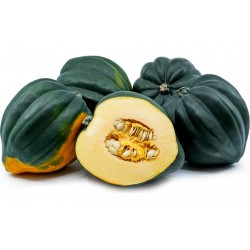
Table Queen Acorn Squash Seeds
Cena
2,25 €
SKU: VG 42
Seeds Gallery Com,
5/
5
<h2><strong>Table Queen Acorn Squash Seeds</strong></h2>
<h2><span style="color:#ff0000;"><strong>Price for Package of 10 seeds.</strong></span></h2>
<p>This dark green squash is acorn-shaped, hence its name. The golden-orange flesh offers a mildly sweet flavor and a somewhat dry texture. Usually about five to eight inches long and four to five inches across, the hardy rind has deep, characteristic ridges with a splash of yellow-gold, considered a sign of maturity.</p>
<p><strong>Nutritional Value</strong></p>
<p>Not as rich in beta-carotene as other Winter varieties, acorn squash is an excellent source of dietary fiber and contains vitamin C, vitamin B6, magnesium and manganese plus a substantial amount of potassium.</p>
<p><strong>Applications</strong></p>
<p>Acorn squash are a hard-skinned, Winter variety. They may be peeled, but are more often cooked with their skin-on. Peel and dice, or cut into slices along the natural ribs; toss with oils, spices or herbs and bake or roast. Serve with or without the skin. Cooked squash may be pureed and added to soups, stews, risotto, cakes or other baked goods. Stuff and bake halves with meats, cheese, grains or other vegetables. Acorn squash will keep at room temperature for many weeks.</p>
<p><strong>Geography/History</strong></p>
<p>The Acorn squash was a favorite of early civilizations as it could be baked whole in their outdoor clay and brick ovens. Dating back to 4000 B.C., acorn squash, sometimes called Danish squash, is an edible gourd that grows on a vine. Generally considered to be a winter squash, the acorn squash is a member of the same family as summer squash, Cucurbita pepo.</p>
<p> </p>
VG 42 (10 S)


Climbing Rose Seeds Pauls...
Cena
2,50 €
SKU: F 76
Seeds Gallery Com,
5/
5
<!DOCTYPE html>
<html>
<head>
<meta http-equiv="Content-Type" content="text/html; charset=UTF-8" />
</head>
<body>
<h2><span style="font-size: 14pt;"><strong>Climbing Rose Seeds “Paul's Scarlet Climber”</strong></span></h2>
<h2><span style="color: #ff0000; font-size: 14pt;"><strong>Price for Package of 10 seeds.</strong></span></h2>
<p>A valuable cultivar of delicately, sweetly scented, deep red flowers. Healthy, frost and disease resistant.</p>
<p><strong>WHAT IT LOOKS LIKE</strong>: Flowers of deep, nearly claret red, ca. 8 cm across, semi-double, gathered in large inflorescences; subtly scented. Bloom abundantly from June-July till the end of summer. Leaves rather small, composed of small glossy leaflets. Annual shoots are very long – up to 3-4 m – thin and supple, easy to train over supports.</p>
<p><strong>HOW IT GROWS</strong>: A primitive climber – does not climb over supports but leans on them. The height of the plant depends mainly on the support size, in Poland it reaches 3-4 m. The support needs to be large and sturdy.</p>
<p><strong>WHERE TO PLANT</strong>: Sunny sites. Well-adapted to nearly every type of soil, but does not tolerate compacted, heavy or sandy and droughty ground. Thrives in light, moderately permeable soil of slightly acidic or neutral pH. Frost hardy (zone 6-8).</p>
<p><strong>HOW TO APPLY</strong>: The rose can be planted along natural supports, usually trunks of trees with loose, open crowns which allows a higher growth. The cultivar recommended for various types of parks and gardens, in areas designed both in formal (e.g. by the main entrance) and natural style. It can be planted along trellises, gates, walls and fences as well as by pergolas and arbours. It's flexible and easily follows the support's shape.</p>
</body>
</html>
F 76

.png)
Yunanistan'dan Çeşitli
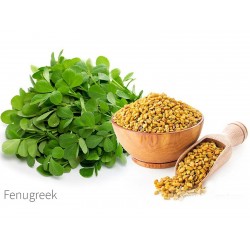
Fenugreek Seeds (Trigonella...
Cena
1,15 €
SKU: VE 64 (2g)
Seeds Gallery Com,
5/
5
<h2><strong>Fenugreek Seeds (Trigonella foenum-graecum)</strong></h2>
<h2><span style="color: #ff0000;"><strong>Price for Package of 140 (2 g) seeds.</strong></span></h2>
<p>Fenugreek (Trigonella foenum-graecum) is an annual plant in the family Fabaceae, with leaves consisting of three small obovate to oblong leaflets. It is cultivated worldwide as a semiarid crop, and its seeds are a common ingredient in dishes from South Asia.</p>
<p><strong>Uses</strong></p>
<p>Fenugreek is used as an herb (dried or fresh leaves), spice (seeds), and vegetable (fresh leaves, sprouts, and microgreens). Sotolon is the chemical responsible for fenugreek's distinctive sweet smell. Cuboid-shaped, yellow- to amber-colored fenugreek seeds are frequently encountered in the cuisines of the Indian subcontinent, used both whole and powdered in the preparation of pickles, vegetable dishes, daals, and spice mixes such as panch phoron and sambar powder. They are often roasted to reduce bitterness and enhance flavor.</p>
<p><strong>Cooking</strong></p>
<p>Fresh fenugreek leaves are an ingredient in some Indian curries. Sprouted seeds and microgreens are used in salads. When harvested as microgreens, fenugreek is known as samudra methi in Maharashtra, especially in and around Mumbai, where it is often grown near the sea in the sandy tracts, hence the name samudra, "ocean" in Sanskrit. Samudra methi is also grown in dry river beds in the Gangetic plains. When sold as a vegetable in India, the young plants are harvested with their roots still attached and sold in small bundles in the markets and bazaars. Any remaining soil is washed off to extend their shelf life.</p>
<p>In Turkish cuisine, fenugreek seeds are used for making a paste known as çemen. Cumin, black pepper, and other spices are added into it, especially to make pastırma.</p>
<p>In Persian cuisine, fenugreek leaves are called "شنبلیله" (shanbalile). They are the key ingredient and one of several greens incorporated into ghormeh sabzi and eshkeneh, often said to be the Iranian national dishes.</p>
<p>In Egyptian cuisine, peasants in Upper Egypt add fenugreek seeds and maize to their pita bread to produce aish merahrah, a staple of their diet.</p>
<p>Fenugreek is used in Eritrean and Ethiopian cuisine. The word for fenugreek in Amharic is abesh (or abish), and the seed is used in Ethiopia as a natural herbal medicine in the treatment of diabetes.</p>
<p>Yemenite Jews following the interpretation of Rabbi Shelomo Yitzchak (Rashi) believe fenugreek, which they call hilbeh, hilba, helba, or halba "חילבה", to be the Talmudic rubia "רוביא". When the seed kernels are ground and mixed with water they greatly expand; hot spices, turmeric and lemon juice are added to produce a frothy relish eaten with a sop. The relish is also called hilbeh;[11] it is reminiscent of curry. It is eaten daily and ceremonially during the meal of the first and/or second night of the Jewish New Year, Rosh Hashana.</p>
<p><strong>Nutritional profile</strong></p>
<p>Per 100 g, fenugreek leaves provide 210 kilojoules (49 kcal) and contain 89% water, 6% carbohydrates, 4% protein and less than 1% fat, with calcium at 40% of the Daily Value (DV, table).</p>
<p>Fenugreek seeds (per 100 g) are rich sources of protein (46% of DV), dietary fiber (98% DV), B vitamins, iron (186% DV) and several other dietary minerals.</p>
<p><strong>Safety</strong></p>
<p>Fenugreek sprouts, cultivated from a single specific batch of seeds imported from Egypt into Germany in 2009, were implicated as the source of the 2011 outbreak of Escherichia coli O104:H4 in Germany and France. Identification of a common producer and a single batch of fenugreek seeds supports the epidemiologic evidence implicating them as the source of the outbreaks.</p>
<p>Some people are allergic to fenugreek, and people who have peanut allergy and chickpea allergy may have a reaction to fenugreek.</p>
<p>Fenugreek seeds can cause diarrhea, dyspepsia, abdominal distention, and flatulence.</p>
<p>There is a risk of hypoglycemia particularly in people with diabetes; it may also interfere with the activity of anti-diabetic drugs.</p>
<p>Because of the high content of coumarin-like compounds in fenugreek, it may interfere with the activity and dosing of anticoagulants and antiplatelet drugs.</p>
<p>It causes birth defects in animals and there are reports that it also causes birth defects in humans, and that it can pass through the placenta; it also appears to negatively affect male fertility, female fertility, and the ability of an embryo in animals and humans.</p>
<p><strong>Traditional medicine</strong></p>
<p>In traditional medicine, fenugreek is thought to promote digestion, induce labor, and reduce blood sugar levels in diabetics, although the evidence for these effects is lacking.</p>
<p><strong>Research</strong></p>
<p>Constituents of fenugreek seeds include flavonoids, alkaloids, coumarins, vitamins and saponins; the most prevalent alkaloid is trigonelline and coumarins include cinnamic acid and scopoletin.</p>
<p>A 2016 meta-analysis combining the results of 12 small studies, of which only three were high quality, found that fenugreek may reduce some biomarkers in people with diabetes and with pre-diabetic conditions, but that better quality research would be required in order to draw conclusions.</p>
<p>As of 2016, there was no high-quality evidence for whether fenugreek is safe and effective to relieve dysmenorrhea.</p>
<p><strong>History</strong></p>
<p>Fenugreek is believed to have been brought into cultivation in the Near East. While Zohary and Hopf are uncertain which wild strain of the genus Trigonella gave rise to domesticated fenugreek, charred fenugreek seeds have been recovered from Tell Halal, Iraq, (carbon dated to 4000 BC) and Bronze Age levels of Lachish and desiccated seeds from the tomb of Tutankhamen. Cato the Elder lists fenugreek with clover and vetch as crops grown to feed cattle. In one first-century A.D. recipe, the Romans flavored wine with fenugreek. In the 1st century AD, in Galilee, it was grown as a food staple, as Josephus mentions it in his book, the Wars of the Jews. A compendium of Jewish oral law known as the Mishnah (compiled in the 2nd century) mentions the plant under its Hebrew name, tiltan.</p>
<p><strong>Etymology</strong></p>
<p>The English name derives via Middle French fenugrec from Latin faenugraecum, faenum Greacum meaning "Greek hay".</p>
<p><strong>Production</strong></p>
<p>Major fenugreek-producing countries are Afghanistan, Pakistan, India, Iran, Nepal, Bangladesh, Argentina, Egypt, France, Spain, Turkey, and Morocco. The largest producer is India. Fenugreek production in India is concentrated in the states of Rajasthan, Gujarat, Uttarakhand, Uttar Pradesh, Madhya Pradesh, Maharashtra, Haryana, and Punjab. Rajasthan accounts for over 80% of India's output.</p><script src="//cdn.public.n1ed.com/G3OMDFLT/widgets.js"></script>
VE 64 (2g)


Bu bitki kış ve dona dayanıklıdır. Açıklamanın daha fazlaörneğine bakın.

Ta roślina ma gigantyczne owoce

Giant Kumquats or cumquats...
Cena
3,25 €
SKU: V 50 G
Seeds Gallery Com,
5/
5
<h2><span style="text-decoration:underline;color:#000000;"><em><strong>Giant Kumquats or cumquats Seeds - exotic tropical fruit</strong></em></span></h2>
<h3><span style="color:#ff0000;"><strong>Price for Package of 3 seeds.</strong></span></h3>
<p><strong><span style="font-size:10pt;">This is a gigantic kumquat, which is more than three times bigger than ordinary kumquat.</span></strong></p>
<p><span style="font-size:10pt;">Kumquats or cumquats are a group of small fruit-bearing trees in the flowering plant family Rutaceae, either forming the genus Fortunella, or placed within Citrus sensu lato. The edible fruit closely resembles that of the orange (Citrus sinensis), but it is much smaller and ovular, being approximately the size and shape of an olive. The English name "kumquat" derives from the Cantonese pronunciation gam1 gwat1 (given in Jyutping romanization).</span></p>
<p><span style="font-size:10pt;">They are slow-growing evergreen shrubs or short trees, from 2.5 to 4.5 meters (8 to 15 ft) tall, with dense branches, sometimes bearing small thorns. The leaves are dark glossy green, and the flowers white, similar to other citrus flowers, borne singly or clustered in the leaf-axils. Depending on size, the kumquat tree can produce hundreds or even thousands of fruits each year.[1] The tree can be hydrophytic, with the fruit often found floating on water near shore during the ripe season.[citation needed]</span></p>
<div><span style="font-size:10pt;">The plant is native to south Asia and the Asia-Pacific region. The earliest historical reference to kumquats appears in literature of China in the 12th century. They have long been cultivated in Japan, Taiwan, the Philippines, and southeast Asia. They were introduced to Europe in 1846 by Robert Fortune, collector for the London Horticultural Society, and shortly thereafter into North America.</span></div>
<div><span style="font-size:10pt;">Classification</span></div>
<div><span style="font-size:10pt;">Carl Peter Thunberg originally classified the kumquats as Citrus japonica in his 1784 book Flora Japonica. In 1915, Walter T. Swingle reclassified them in a segregate genus, Fortunella, named in honor of Robert Fortune. Seven species of Fortunella have generally been recognized—F. japonica, F. margarita, F. crassifolia, F. hindsii, F. obovata and F. polyandra, as well as the recently described F. bawangica . The Flora of China returns the kumquat to Citrus and combines the species into the single species as Citrus japonica.[2]</span></div>
<div><span style="font-size:10pt;">Varieties :</span></div>
<div><span style="font-size:10pt;">Round kumquat</span></div>
<div><span style="font-size:10pt;">The round kumquat (also Marumi kumquat or Morgani kumquat) is an evergreen tree, producing edible golden-yellow colored fruit. The fruit is small and usually round but can be oval shaped. The peel has a sweet flavor but the fruit has a sour center. The fruit can be eaten cooked but is mainly used to make marmalade and jelly. It is grown as an ornamental plant and can be used in bonsai. This plant symbolizes good luck in China and other Asian countries, where it is sometimes given as a gift during the Lunar New Year. It's more commonly cultivated than most other kumquats as it is cold tolerant. It can be kept as a houseplant.</span></div>
<div><span style="font-size:10pt;">When the kumquats are divided into multiple species the name Fortunella japonica (Citrus japonica) is retained by this group.</span></div>
<div><span style="font-size:10pt;">Oval kumquat</span></div>
<div><span style="font-size:10pt;">Fortunella margarita, also known as the oval kumquat or the Nagami kumquat, is a close relative to Citrus species. It is a small evergreen tree, that can reach more than 12 ft (4 m) high and 9 ft (3 m) large. It is native to southeastern Asia, and more precisely to China. The oval kumquat has very fragrant citrus-like white flowers, and small edible oval orange fruits. The oval kumquat is an ornamental little tree, with showy foliage, flowers and fruits. It is also fairly frost-hardy, and will withstand negative temperatures such as 14 °F (-10 °C), and even a little lower for very brief periods. It can be grown in USDA hardiness zones 9 and warmer, but can also be tried in sheltered places, in USDA hardiness zone 8. Unlike most citrus species, the oval kumquat has a shorter growth period, and goes into dormancy fairly earlier in autumn. This partly explains its better frost hardiness.</span></div>
<div><span style="font-size:10pt;">Characteristics</span></div>
<div><span style="font-size:10pt;">The evergreen leaves of oval kumquats are deep-green and relatively small. They can reach up to 3 in (7 cm) long and 1.5 in (3.5 cm) wide. The white flowers of the oval kumquat are similar to the citrus flowers. They are strongly perfumed, and they appear relatively late in the growing season, generally late spring.</span></div>
<div><span style="font-size:10pt;">The oval kumquat is a fruit that looks like any citrus fruit, with an orange rind. The fruits are oblong, up to 2 in (5 cm) long. Unlike the common citrus, which have a rind which is inedible raw, oval kumquats have an edible sweet rind. The flesh, however, is not as sweet as the rind, and the juice is quite acidic and sour, with a lemon-like flavor. This fruit is generally eaten fresh, with its rind. It can also be processed into preserves, jams, and other products.</span></div>
<div><span style="font-size:10pt;">Cultivation</span></div>
<div><span style="font-size:10pt;">The oval kumquat needs a well-drained and fertile ground. It dislikes alkaline soils. The oval kumquat is susceptible to common citrus pests and diseases.</span></div>
<div><span style="font-size:10pt;">Jiangsu kumquat</span></div>
<div><span style="font-size:10pt;">The Jiangsu kumquat or Fukushu kumquat bears edible fruit that can be eaten raw. The fruit can be made into jelly and marmalade. The fruit can be round or bell shaped; it is bright orange when fully ripe. It may also be distinguished from other kumquats by its round leaves that make this species unique within the genus. It is grown for its edible fruit and as an ornamental plant. It cannot withstand frost.</span></div>
<div><span style="font-size:10pt;">When the kumquats are divided into multiple species the name Fortunella obovata (Citrus obovata) is used for this group.</span></div>
<div><span style="font-size:10pt;">Cultivation and uses</span></div>
<div><span style="font-size:10pt;">Kumquats are cultivated in China, South Korea, North Korea, Taiwan, Southeast Asia, Japan, the Middle East, Europe (notably Corfu, Greece), southern Pakistan, and the southern United States (notably Florida, Louisiana, Alabama) and California.</span></div>
<div><span style="font-size:10pt;">They are much hardier than other citrus plants such as oranges. The 'Nagami' kumquat requires a hot summer, ranging from 25 °C to 38 °C (77 °F to 100 °F), but can withstand frost down to about −10 °C (14 °F) without injury. They grow in the tea hills of Hunan, China, where the climate is too cold for other citrus fruits, even the Mikan (also known as the Satsuma) orange. The trees differ also from other citrus species in that they enter into a period of winter dormancy so profound that they will remain in it through several weeks of subsequent warm weather without putting out new shoots or blossoms. Despite their ability to survive low temperatures, kumquat trees grow better and produce larger and sweeter fruits in warmer regions.</span></div>
<div><span style="font-size:10pt;">Uses</span></div>
<div><span style="font-size:10pt;">Kumquats are often eaten raw. As the rind is sweet and the juicy center is sour, the raw fruit is usually consumed either whole—to savor the contrast—or only the rind is eaten. The fruit is considered ripe when it reaches a yellowish-orange stage and has just shed the last tint of green.</span></div>
<div><span style="font-size:10pt;">Culinary uses include candying and kumquat preserves, marmalade, and jelly. Kumquats can also be sliced and added to salads. In recent years kumquats have gained popularity as a garnish for cocktail beverages, including the martini as a replacement for the more familiar olive. A kumquat liqueur mixes the fruit with vodka or other clear spirit. Kumquats are also being used by chefs to create a niche for their desserts and are common in European countries.</span></div>
<div><span style="font-size:10pt;">The Cantonese often preserve kumquats in salt or sugar. A batch of the fruit is buried in dry salt inside a glass jar. Over time, all the juice from the fruit is diffused into the salt. The fruit in the jar becomes shrunken, wrinkled, and dark brown in color, and the salt combines with the juice to become a dark brown brine. A few salted kumquats with a few teaspoons of the brine/juice may be mixed with hot water to make a remedy for sore throats.[citation needed] A jar of such preserved kumquats can last several years and still keep its flavor.[citation needed]</span></div>
<div><span style="font-size:10pt;">In the Philippines and Taiwan, kumquats are a popular addition to green tea and black tea, either hot or iced.</span></div>
<div><span style="font-size:10pt;">In Vietnam, kumquat bonsai trees (round kumquat plant) are used as a decoration for the Tết (Lunar New Year) holiday. Kumquat fruits are also boiled or dried to make a candied snack called mứt quất.</span></div>
<div>
<div>
<div>
<table cellspacing="0" cellpadding="0" border="1"><tbody><tr><td colspan="2" width="100%" valign="top">
<p><span style="color:#008000;font-size:10pt;"><strong>Sowing Instructions</strong></span></p>
</td>
</tr><tr><td valign="top" nowrap="nowrap">
<p><span style="color:#008000;font-size:10pt;"><strong>Propagation:</strong></span></p>
</td>
<td valign="top">
<p><span style="color:#008000;font-size:10pt;">Seeds</span></p>
</td>
</tr><tr><td valign="top" nowrap="nowrap">
<p><span style="color:#008000;font-size:10pt;"><strong>Pretreat:</strong></span></p>
</td>
<td valign="top">
<p><span style="color:#008000;font-size:10pt;">0</span></p>
</td>
</tr><tr><td valign="top" nowrap="nowrap">
<p><span style="color:#008000;font-size:10pt;"><strong>Stratification:</strong></span></p>
</td>
<td valign="top">
<p><span style="color:#008000;font-size:10pt;">0</span></p>
</td>
</tr><tr><td valign="top" nowrap="nowrap">
<p><span style="color:#008000;font-size:10pt;"><strong>Sowing Time:</strong></span></p>
</td>
<td valign="top">
<p><span style="color:#008000;font-size:10pt;"> all year round </span></p>
</td>
</tr><tr><td valign="top" nowrap="nowrap">
<p><span style="color:#008000;font-size:10pt;"><strong>Sowing Depth:</strong></span></p>
</td>
<td valign="top">
<p><span style="color:#008000;font-size:10pt;">0.5-1 cm</span></p>
</td>
</tr><tr><td valign="top" nowrap="nowrap">
<p><span style="color:#008000;font-size:10pt;"><strong>Sowing Mix:</strong></span></p>
</td>
<td valign="top">
<p><span style="color:#008000;font-size:10pt;">Coir or sowing mix + sand or perlite</span></p>
</td>
</tr><tr><td valign="top" nowrap="nowrap">
<p><span style="color:#008000;font-size:10pt;"><strong>Germination temperature:</strong></span></p>
</td>
<td valign="top">
<p><span style="color:#008000;font-size:10pt;">min. 20° C.</span></p>
</td>
</tr><tr><td valign="top" nowrap="nowrap">
<p><span style="color:#008000;font-size:10pt;"><strong>Location:</strong></span></p>
</td>
<td valign="top">
<p><span style="color:#008000;font-size:10pt;">bright + keep constantly moist not wet</span></p>
</td>
</tr><tr><td valign="top" nowrap="nowrap">
<p><span style="color:#008000;font-size:10pt;"><strong>Germination Time:</strong></span></p>
</td>
<td valign="top">
<p><span style="color:#008000;font-size:10pt;">Until it Germinates 7days - 2 Months</span></p>
</td>
</tr><tr><td valign="top" nowrap="nowrap">
<p><span style="color:#008000;font-size:10pt;"><strong>Watering:</strong></span></p>
</td>
<td valign="top">
<p><span style="color:#008000;font-size:10pt;">Water regularly during the growing season</span></p>
</td>
</tr><tr><td valign="top" nowrap="nowrap">
<p><span style="color:#008000;font-size:10pt;"><strong> </strong></span></p>
</td>
<td valign="top">
<p><br /><span style="color:#008000;font-size:10pt;">Seeds Gallery 05.11.2012.</span></p>
</td>
</tr></tbody></table></div>
</div>
</div>
V 50 G

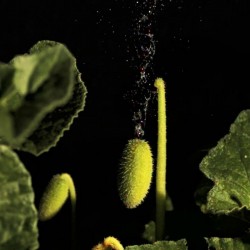
Squirting Cucumber Or...
Cena
1,80 €
SKU: PK 7
Seeds Gallery Com,
5/
5
<h2><strong>Squirting Cucumber Or Exploding Cucumber Seeds (Ecballium elaterium)</strong></h2>
<h2><span style="color:#ff0000;"><strong>Price for Package of 5 or 10 seeds.</strong></span></h2>
<p>Squirting cucumber (Ecballium elaterium), trailing herbaceous plant in the gourd family (Cucurbitaceae). The plant is native to the Mediterranean region but has been introduced to other areas as a garden curiosity for its distinctive explosive fruits. Squirting cucumber contains poisonous cucurbitacins, and all parts of the plant can be fatal if ingested.</p>
<p>The hairy, rough, thick-stemmed plant may spread out to about 60 cm (about 24 inches) and has yellow bell-shaped flowers. The long-stalked bluish green fruits are about 4–5 cm (1.6–2 inches) long. Upon reaching maturity, the fruits explosively eject their brown seeds as they detach from the stem; the seeds may travel 3 to 6 metres (about 10 to 20 feet) from the plant.</p>
<p>Before we delve into the plant’s historical usage, let’s be clear that squirting cucumber contains high levels of cucurbitacins, which can be fatal if ingested. That said, the bitter cucurbitacin was cultivated in England and Malta into the nineteenth century to control worms. It has been used as a medicinal plant for over 2,000 years with explosive effects upon the human body worthy of its name. Apparently, the more benign effects treat rheumatism, paralysis, and cardiac disease. The root is said to be an analgesic and topically squirting cucumber was used to treat shingles, sinusitis, and painful joints. However, the more volatile effects are purgative and abortive. Large doses have caused gastro enteritis and death. At any rate, modern herbalists do not utilize squirting cucumber at this juncture nor should you.</p>
<p><strong>Disclaimer: The contents of this article is for educational and gardening purposes only. Before using ANY herb or plant for medicinal purposes, please consult a physician or a medical herbalist for advice.</strong></p>
<p><strong></strong></p><video width="640" height="320" controls=""><strong></strong><source src="http://i.imgur.com/3TZEsSu.mp4" type="video/mp4"><strong></strong></source><strong></strong></video><strong></strong>
<h3><span style="color:#ff0000;font-size:18pt;"><em><a href="http://i.imgur.com/3TZEsSu.mp4" target="_blank" rel="noreferrer noopener"><span style="color:#ff0000;">Squirting Cucumber video</span></a></em></span></h3>
<h2>WIKIPEDIA:</h2>
<p>Ecballium is a genus of flowering plants in the family Cucurbitaceae containing a single species, Ecballium elaterium, also called the squirting cucumber or exploding cucumber (but not to be confused with Cyclanthera explodens). It gets its unusual name from the fact that, when ripe, it squirts a stream of mucilaginous liquid containing its seeds, which can be seen with the naked eye. It is thus considered to have rapid plant movement.</p>
<p>It is native to Europe, northern Africa, and temperate areas of Asia. It is grown as an ornamental plant elsewhere, and in some places it has naturalized.</p>
<p>It is suspected to provide food for the caterpillars of the tortrix moth Phtheochroa rugosana.</p>
<p><strong>This plant, and especially its fruit, is poisonous, containing cucurbitacins. In the ancient world it was considered to be an abortifacient.</strong></p>
<p>Elaterium or elaterin is the name of the greenish substance extracted from the juice of the fruit that is used as a purgative.</p>
PK 7 (5 S)





